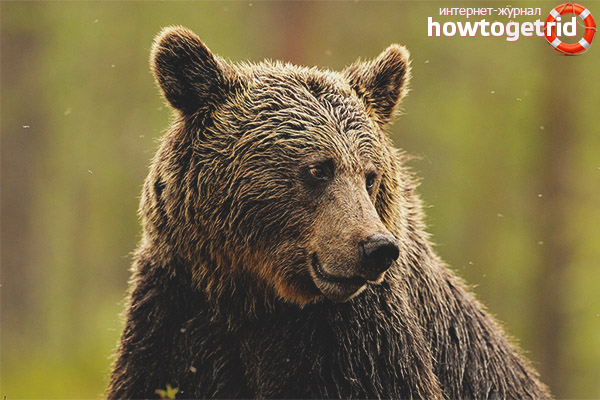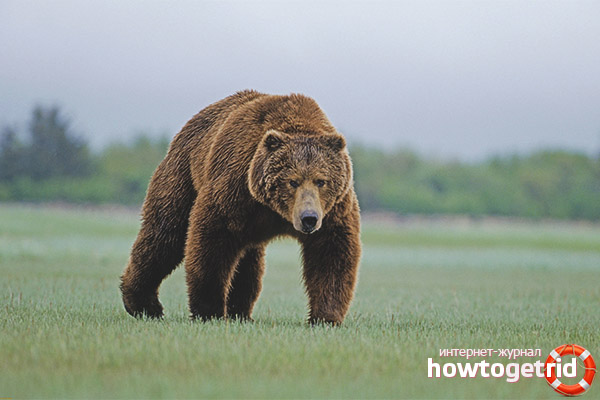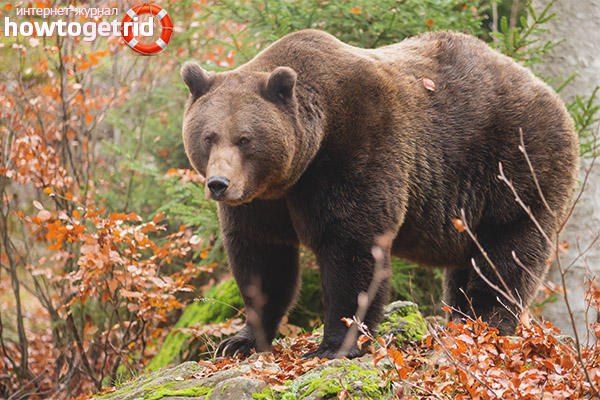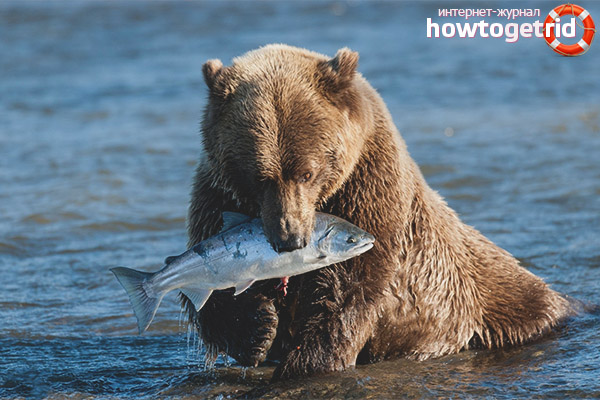The content of the article
The image of a brown bear is well known to Russian people from folk tales. One immediately recalls how the girl hosted the house of a family of bears, which greatly upset the little Bear. Others would like to chant the words of Mashenka sitting in a wicker box of a bear. However, the fame of the animal is not limited to these examples, since we also find it in folklore: proverbs, winged expressions, songs. Immersed in folk culture, you can easily find that in the people's minds, the brown bear was brave, with remarkable strength, as well as a simple-hearted and kind character.
In northern folklore, his identity manifests itself in the image of a lion as the king of the animal world, because for the inhabitants of taiga lands the bear was a real master: it depended on him whether the tribes would live peacefully or they would be ruined and hunger. He was a totem, the patron saint of hunting, as evidenced by bear symbolism on ritual objects and household items, today stored in many historical and ethnographic museums. The brown bear, not sparing anyone in its path, among other things, inspired fear in the ancient man, because from him came a force with which it was difficult for people to measure.
Appearance
Before we touch on environmental issues, we describe what the beast looks like. Like other representatives of the fauna, this animal has a traditional Latin name - Ursus arctos. Known to any adult and child, the brown bear belongs to the bear family.
Weight size
It is distinguished by its large size, sometimes exceeding the dimensions of its other brothers. The only exception is the Arctic white bears, still holding the lead in this descriptive criterion. Brown bears owe this size primarily to their growth. The largest individuals live on the territory of one of the northern American states, which was once part of the Russian Empire. We are talking about Alaska, densely populated by Kodiaks (the name of the species), whose length can reach a size of 2 meters 80 centimeters and a height of 1 meter 60 centimeters. It's hard to believe, but the average weight of such kodiak is 750 kilograms. However, this is far from the limit. In the long history of zoology, there was a case when a brown bear of a staggering size was caught to expand the species diversity of the Berlin Park. After weighing it, employees recorded a figure that exceeded the bar of 1 ton - 1134 kilograms.
Large individuals are also found on the territory of modern Russia. So, bears live on the Kamchatka Peninsula, the length of which varies from 1 meter 30 centimeters to 2 meters 50 centimeters. It is worth noting that such characteristics as weight, length, height often depend on gender. It is known that females are often inferior to males in them.
Wool
Does this forest resident have a thick coat? Of course yes. Without it, the bear would have been very hard, because such a cover helps him at all times of the year: in the summer it does not harm the animal with obstinate insects, in the spring and summer it saves from bad weather. She succeeds in achieving such an effect thanks to the unique composition - the animal’s hair has two important layers. The first - short and fluffy villi, reminiscent of fluff, allow you to keep warm body temperature. The second is a dense and long pile that does not absorb moisture, but protects the bear from it.
The breadth of the color scheme of the coat color varies within the same color - brown. However, we remember that the natural world is distinguished by a variety of shades.Therefore, the coloristic palette of brown bears cannot be called scarce. The color of the coat of brown bears varies depending on the climatic zone in which the animals live. So, all over our vast globe, you can meet those bears whose color tends to gold, and those whose coat color is close to black. It is known that the inhabitants of the Himalayan forests are characterized by a bright spot in the back, and the Syrian individuals often have a red color. Russian bears are characterized by a traditional brown shade of wool. But it is important to remember that the territory of our country is very large and includes different climatic zones. All this contributes to the fact that in Russia there are different subspecies, and therefore - different colors, often very different from the generally accepted.
Molting
Speaking of the fur of the beast, it is worth recalling the molting. It happens once a year. Its duration stretches for three seasons, starting in the spring and ending in the winter months. Sluggish nature is characterized by molting during wilting nature - in the autumn. A total change of the bear hairline occurs right before the animal goes to the den.
Body structure
A distinctive feature of the appearance of the brown bear is the protruding part of the back in the withers area, which gives a stoop to the profile silhouette of the animal and resembles a hump. But in reality, it is not so, since this relief is caused by a buildup of muscles. It is she who contributes to the agility and ease with which the bears dig the earth. The main shock force of an already powerful animal is concentrated in it.
The bear’s head is heavy. The pronounced frontal part makes it larger and gives the appearance of the beast rigor. It is no coincidence that in songs, poems and fables next to the image of a bear there is such a definition as stubborn. The weighty head is crowned with small ears, in the center of the muzzle you can see the eyes set deep into the face. The bear’s most awesome thing, of course, is its mouth. Forty teeth are fangs and incisors, the remaining small teeth are called vegetarian. The specific structure of the cranium provides this arsenal with enough space for fastening the jaw muscles. Such equipment makes the beast bite monstrously strong: a brown bear is able to tear flesh to pieces.
Going down in the description of the appearance below, we pay attention to the paws. Being five-fingered, they have huge claws, up to ten centimeters in length. If necessary, the bear is able to draw them in. The bear uses its claws both in hunting and gathering, as it is convenient not only to grab prey, but also to dig up your favorite tubers and plant roots, as well as flower bulbs.
The skin coating of the toes of the feet is rude. Usually it is painted in all kinds of shades of brown. The most important similarity between a man and a bear is not their equal love for meat and plants, but the ability to walk upright. Particular attention should be paid to his unique gait, obtained by using all four limbs. Stepping in turn on the two right, then on the two left, he seemed to swing. It was this property that gave rise to an integral feature of his image - clubfoot.
Brown bears are also famous for their olfactory abilities, although vision and hearing leave much to be desired. Imagine his scent is a hundred times better than that of a person. He can smell his favorite honey for 7 kilometers. It will not be so easy to hide or run away from such an animal if it could catch your smell, and for some reason it will become interesting to him!
Habitat
The distribution area of the brown bear is huge.Where does this strong and brave beast live? He conquered most of Europe and Asia; the central and northern regions of the North American continent did not hide from them. The most popular habitats of brown bears are the territory of the United States of America, Canada, Eastern Siberia and, of course, the Far Eastern expanses. The home for the brown bear is the forest.
Impassable thickets near a small river or peat bog - an earthly paradise for representatives of this species. However, this does not mean that they do not like the rocky territories. If there is a mixed forest, as well as a mountain stream, then a population of brown bears can be safely expected in this place.
Zoologists often classify bears according to identified species according to habitat. Such subspecies mainly differ in color and size. Interestingly, the researchers were able to deduce the following pattern: the size of individuals of various subspecies enlarges when moving to the pole. This fact is easily explained by the fact that in difficult conditions, larger bears are much easier to survive.
Lifestyle
The habits and character of the animal are determined by its craving for loneliness. The size of the residence of one male can reach three hundred kilometers, while females with offspring require a space seven times smaller. The territory is assigned to an individual by leaving stem marks-smells and marks-marks. Brown bears rarely roam and tend to settle. The reasons for the change of residence may be the need to find food, the desire to overcome the approximation of a person's place of residence.
The previously mentioned stubbornness manifested itself in the character of the animal. Brown bears are very stubborn animals. Perseverance is a prerequisite for food. The bear is able to show persistence both in routines and in unique cases, such as the desire to get a rare and favorite treat. It is known that the fruit seen on the tree will first try to get the beast by reaching out or climbing the trunk. If such humane methods make him fail, the bear will not be at a loss. He simply begins to shake the poor tree until the desired fruit becomes his property.
The strong memory of brown bears is another unique property of animals of this species. It is she who becomes an excellent foundation for the development of mental skills. Young bears are distinguished by a sharp mind and quick wit. So, hunters have often noticed that having discovered a trap, the bear not only tried to avoid getting into it, but made attempts to neutralize it with the help of improvised natural means such as sticks, stones.
Animals also differ in fair curiosity, but this does not apply to humans. Animals always try to prevent meetings with him. But, if this happened, the bear does not always choose the tactics of attack: it can simply remain in observation or snort with displeasure towards the forest guest.
Everyone knows that brown bears go to sleep during the winter. Before that, they eat a lot of food, because they tend to accumulate the necessary fat reserve for wintering. Heading to their lair, the animals deliberately stray to confuse their footprints and prevent the possibility of ruining their shelter. In hibernation, the beast spends from two to six months. The duration of suspended animation depends on the habitat and temperature indicators. Male and female individuals lie separately, if the female has acquired offspring, then the cubs spend the first year of life in a den with a bear.
Important! The myth is the belief that all bears suck their paw. In fact, such a behavioral feature is characteristic only for babies.
The sleep of the beast is particularly sensitive. First of all, it manifests itself in the fact that an awakened bear cannot sleep again.Then the connecting rod bear will roam the winter forest. If a person meets a brown bear during this period of time, most likely, the outcome of the event will be an attack by the beast.
Food
Brown bears are omnivores. They prefer plant foods, which make up 75 percent of the total diet. Beasts eat bulbs, roots, shoots and fruits. If the bear lives near the person’s place of residence, he can visit his garden or housekeeping on corn plantations.
25 percent of food of animal origin are insects, small rodents, amphibians and reptiles, fish. Often, bears resort to eating carrion. Gathering in search of food from the owners of the forest is more popular, unlike hunting.
Breeding
The female gives birth approximately every 3 years. The estrus period begins in late spring and lasts from ten to thirty days. It was at this time that the males behaved noisily: a roar spreads through the forest. The manifestation of aggression is also characteristic of bears during the heat of the dipper. Males are able to confront each other, sometimes such fights end in death.
The pregnancy of the bear lasts for two hundred days, the cubs are born in the den in January. Usually cubs are deaf, blind, and slightly covered with down. Fourteen days after birth, they begin to hear, after thirty - to see. The bear feeds the babies for four months, after which they begin to eat plant foods. If during a suspended animation the bear is awakened, she, just like the male, will leave the den and will not return to it, even though her children will remain defenseless there.
Video: Brown Bear (Ursus arctos)













Submit